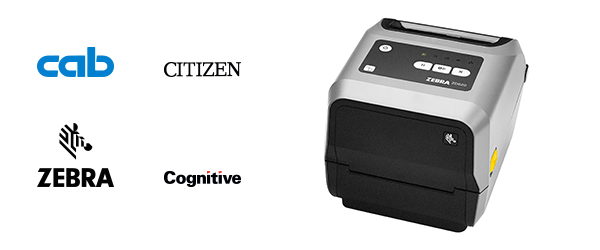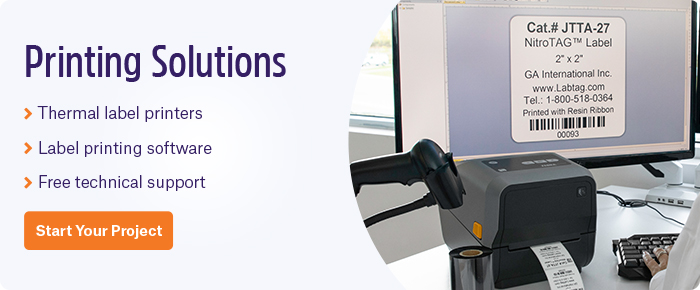So, you’ve decided that switching from a laser to a thermal-transfer barcode printer is right for your lab. Whether this is because your label printout keeps smearing due to chemical exposure or you’re having difficulty scanning your barcodes, there are some key factors you can expect to encounter when making the switch to thermal-transfer printing.
No Toner Required
Toner is usually the biggest expense associated with laser printers. Toner cartridges can be expensive and not especially efficient. Some ink cartridges will be considered empty, though as much as 40% of their ink remains, and some printers won’t even allow you to print until the cartridge is changed. Therefore, people who own laser printers are throwing away a lot of usable ink, and with the cost of an average 8 milliliter blank-ink cartridge at $10 (which translates into $1250 per liter of ink), that’s a lot of squandered product. Thermal-transfer printers use ink ribbons that do not require replenishing until the entire roll is used, yielding less waste.
Small and Portable
Laser printers tend to be large and bulky machines that only print full sheets of labels. They also require a computer as a terminal. Thermal-transfer printers, however, are about one-third of the size of the average laser printer, making them lightweight and portable. They can be linked to a computer via wireless connectivity (e.g. Bluetooth or Wi-Fi) or used as standalone printers, allowing you to design your labels using the interface associated with the printer. The portability of this label printing system also permits them to be shared across several labs or departments.
Won’t Jam
Printing with a laser printer generates a large amount of heat, which can affect the integrity of your label’s adhesive. This can result in the oozing of the adhesive, leading to jams. Moreover, while you don’t necessarily have to print an entire sheet of labels at once, using a sheet where several of the labels have been removed can result in an uneven surface, altering the movement of the sheet through the printer, which can also jam the printer. Thermal-transfer labels generate far less heat, and what heat is used is more precisely applied. In addition to its use of rolls instead of sheets, thermal-transfer printers are nearly impossible to jam.
Improved Efficiency
Because thermal-transfer labels come in rolls, you can print the exact number of labels that you need without using more materials than required. Laser printing is only available in sheet format, so you either need to use the entire sheet of labels or risk jamming your printer when you use the sheet a second or third time, potentially halting the entire process.
Better Chemical Resistance
While laser labels afford some resistance to alcohols, thermal-transfer printouts afford superior resistance to harsh chemicals and solvents that would be impossible with laser labels without the use of a protective laminate. This is especially important for labels used in histology, where they typically undergo immersion in xylene, toluene, hematoxylin, and eosin, all of which can cause your printout to smudge or fade completely. Automated histology systems like BD’s FocalPoint™ also require barcoded labels, with specific requirements for barcode quality; thermal-transfer printouts minimize the damaging effects of the solvents, making it more likely that the barcodes will remain readable during sample processing.
Better Temperature Resistance
Both laser and thermal-transfer printouts are resistant to extreme temperatures. Using either method, labels will resist cryogenic storage at -196°C (-320.1°F) or autoclaving at 150°C (302°F) and 30 psi. However, thermal-transfer printouts can also resist temperatures as high as 400°C (752°F) and cryogenic storage in liquid helium -269°C (-452.2°F).
Sharper Barcodes
Thermal-transfer printers provide overall sharper barcodes on your labels compared with laser printing. This makes thermal-transfer–printed barcodes more likely to pass verification (a process that ensures the quality of your barcodes by grading them based on multiple parameters) than laser labels, thus increasing the likelihood that thermal-transfer labels will be read by the scanner.
There are a variety of printer options available when making the switch to thermal-transfer labels, from Cab and Citizen to Zebra. In addition, thermal-transfer ribbons can also be made of either wax, resin, or a blend of both, although resin ribbons typically provide the most protection against extreme temperatures and chemical exposure. Download our Printer Buying Guide to help you make the right selection.
LabTAG by GA International is a leading manufacturer of high-performance specialty labels and a supplier of identification solutions used in research and medical labs as well as healthcare institutions.





